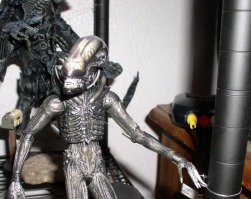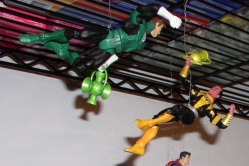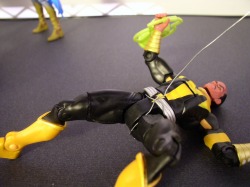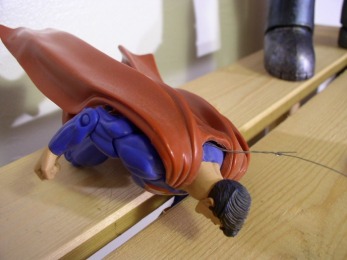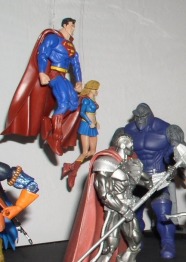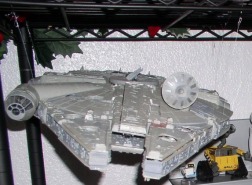Building a Display, Part 2: Wire
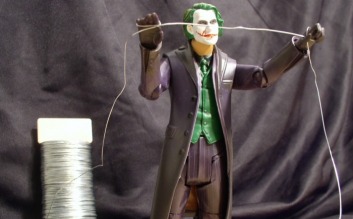
Last time we looked at some basic types of toy displays. Today, we're going to focus a little more on a specific detail: wire.
Why use wire? Well, for one thing it helps figures stand up. In addition, it opens the door for a variety of display options that would be otherwise unavailable. I happen to be a believer that Superman should be flying: wire makes this possible.
Now, there are many different kinds of wire. I use simple floral wire, because it's cheap and easy to find. If you want to hunt down something more attractive, go ahead: I'm too lazy.
Also, I shouldn't need to say this, but I'm going to anyway. Wire is metal, so you using it could leave a mark. Personally, I've lost a lot more paint from figures falling off shelves because they didn't have wire than I have from wire itself. But, if leaving your playthings in pristine condition is a priority, this isn't going to help.
Lets take a look at a couple examples. We'll start by taking a look at The Alien, created by NECA. It's a good looking toy, but mine has some articulation issues. When I first pulled it out of the package, two of its joints snapped immediately. Rather than take it back to the store (like I probably should have), I asked my wife to glue him back together. She got him looking right, but that doesn't fix the problems with his joints, so I have limited options on how far I can adjust him.
|
As a result, he doesn't stand up too well on his own. The solution, of course, is wire. |
|
Lets turn our attention back to Green Lantern and his nemesis, Sinestro. Rather than display them on the already crowded ground, I decided to hoist them in the air. |
Superman was a little easier. I ran the wire around the center peg which attaches his cape to his body. Then it was just a matter of wrapping it around the pegs above. I used the same basic technique on Supergirl.
That's all fine and good, you might be saying, but how about larger toys. Well, it doesn't get much larger than this Millennium Falcon model (or it doesn't in my collection: I have a small apartment!). I used a couple lengths of wire for this, crossing for an 'x' pattern. One of the advantages wire has over string (beside being sturdier) is that it's malleable. I formed the 'x" into the shape I wanted and set the Falcon down.
|
Then began the adjustments. Oh, you didn't think it was that easy, did you? I raised, lowered, and shifted each wire until I had the angle and the height I wanted. When I was done, the Millennium Falcon was soaring over the other toys on my SF shelf. |
Until then, I keep a blog on all things geek. Check it out if you've got some time to spare.
